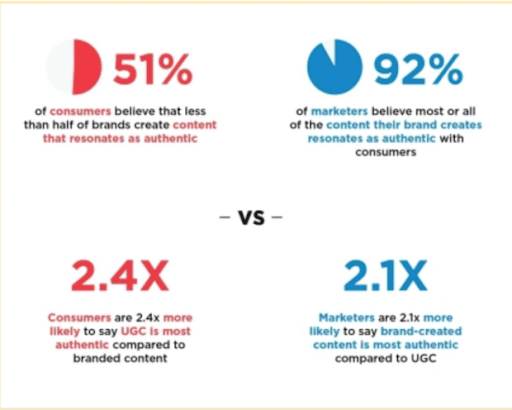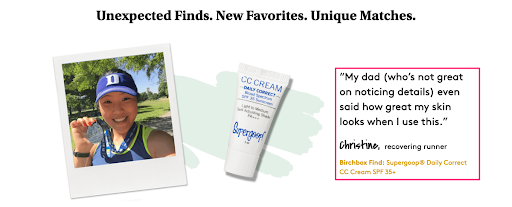Rebecca Barnatt-Smith
Rebecca is a freelance journalist and multi-media marketing executive, specialising in the future of social media marketing and immersive technology in business.
Tap into the goldmine of user-generated content. Elevate brand trust and engagement in a fiercely competitive online landscape. Your ultimate guide awaits!
User-generated content is becoming a goldmine for content marketers across the globe. With over 79% of people claiming that UGC significantly impacts their purchasing decisions in 2023, it’s no wonder marketers rate it as a strategy for success.
As the competition to score leads becomes toucher in an online world, user-generated content allows brands to showcase the reviews, quotes and visuals of their most loyal consumers in an attempt to win the trust of a hard-to-please demographic.
“In today’s fiercely competitive online landscape, brands benefit from the sentiments, reviews and attention their customers provide,” claims Dylan Duke, Founder and CEO of Glewee. “It’s the proof brands need to know their customers love what they offer and the proof consumers need to become customers of a brand.
This value proposition of UGC and its power to drive conversions and increase purchase intention make it a prime choice for marketers.” With that in mind, we’ve put together the ultimate guide to implementing user-generated content into your own content strategy for a chance at increasing brand engagement amongst competition highs.
User-generated content, also known as UGC, is a piece of brand-specific content that a consumer has created. These types of content are original and can come in a number of forms, ranging from reviews to videos to even podcast testimonials.
With so many platforms open to the public to post and share their own digital content, the opportunities to create and deliver brand-related content continue to grow. According to experts at Hootsuite: “UGC gives customers a unique opportunity to participate in a brand’s growth instead of being a spectator.
This influences brand loyalty and affinity in a big way because people thrive off being part of something greater than themselves, and creating UGC allows them to be part of a brand’s community.”
Businesses that actively encourage their consumers to create brand-specific content are more likely to see higher levels of engagement across numerous channels and a boost in awareness as consumers write about and link out to products or services within their own social communities.
The question is, could UGC be the key to content marketing success? In an era where brands are fighting to be seen online, buyers, as a result, have become more selective about the products and services they plan to spend their money on.
One way to improve your chances of conversion is to build trust with a notoriously fussy digital audience. UGC does just this. Over 60% of content marketers believe that UGC helps promote authenticity and quality within a content strategy, two essential drivers of engagement in the e-commerce world.
Consumers also agree, with most online browsers now 2.4 times more likely to view user-generated content as authentic in comparison to in-house branded posts.

Authenticity alone already drives the argument for including UGC within your content strategy. However, there are plenty more benefits associated with incorporating consumer-created content within your social feed, website design and online ads.
From growing a community to influencing purchasing decisions, let’s have a closer look at some of the benefits associated with introducing user-generated content to your marketing strategy.
UGC turns a customer into a partner rather than just a spectator. Finding ways to include your consumers within your business growth helps build brand loyalty and foster a community of returning purchasers.
UGC is also a conversation starter between a consumer and the brand. Suppose you release your own UGC competition or start responding to and showcasing positive reviews and testimonials. In that case, you quickly humanize your brand as a place that values each and every communication it receives from returning customers.
Did you know that a whopping half of all millennials base their purchasing decisions on ‘word of mouth’ marketing from family and friends?
If you’re consistently sharing honest customer reviews and testimonials, this proves to your audience that you are proud of your product/services and are open to criticism. This acts as a trust signal and a sign of authenticity for those still making a purchase decision.
“Adding user-generated content into your marketing efforts can help you show your authenticity and build trust because many people trust consumer opinions posted online more than other types of traditional advertising,” says Rebecca Kowalewicz, Vice President at Clearbridge Branding Agency.
“Consumers typically avoid buying products and services from companies that they don’t trust, so user-generated content can be a profitable sales tool as well.”
Did you know that e-commerce campaigns that include UGC see 29% more conversions than ones without consumer input?
This is why UGC is hugely influential during the closing period of a buyer’s journey. When acquiring a lead, ensure that they are always seeing real-life reviews and testimonials on site, and even targeted social ads and emails packed full of consumers' visuals, compliments and voices.
“UGC builds consumer confidence. It is an incredibly effective way for a brand to influence its audience and convert them into buyers,” continues Duke. “When your audience sees people just like them wearing or using a product, it feels more relatable and helps influence them to purchase.”
Now we’ve discovered the benefits of a user-generated content campaign, let’s have a closer look at how you can leverage customer content for your own strategy success. Here are three ways to start weaving UGC into your content strategy:
The most obvious way to introduce more consumer-led content into your marketing strategy is to release a standalone UGC campaign. These types of campaigns are usually performed over social media and often encourage consumers to create a piece of content in exchange for a prize, offer, mention or share.
These can be in the form of chunky challenges, hashtag-led posting and other incentives such as a rewarded competition.

Take Apple as an example. In an attempt to showcase the quality of its newest iPhone camera, the tech brand released its own “Shot on iPhone” campaign that encouraged users to post their own pictures under the same hashtag for a chance to be featured on Apple’s follower-heavy Instagram feed.
Another way to introduce UGC to your content strategy is to start including customer reviews and testimonials on your website. One of the first things a potential buyer does when making a first-time purchase is search for reviews on the product or service.
In order to make this process more streamlined, display your positive reviews and testimonials below individual products for the best results. Take this example from Birchbox, for instance. Using both a quote and a visual of the reviewer helps humanize the testimonial and is a simple way to build trust with new leads.

However, when reviewing customer testimonial submissions, ensure that you check for content authenticity. As mainstream language bots such as ChatGPT take over the online world, it’s important to detect AI writing that could impact the reputation of your brand.
Last but not least, don’t forget about customer forums. This may feel like an outdated version of a UGC strategy, but it still remains one of the most effective.
Taking a step back and letting your consumers converse about your brand in their own space helps build a community surrounding your products and services.

Take Apple, for example; their support communities help boost brand awareness and engagement while taking pressure off of customer service agents who can redirect their efforts into more extensive complaints and inquiries.
Creating and nurturing an online community is a great way to boost brand loyalty.
The UGC scene is undoubtedly heating up in 2023. As TikTok thrives and digital natives become more comfortable in posting their own content, brands have more opportunities than ever to leverage this for strategy success.
“UGC is authentic and more experience-driven than brand-pushed content because no fabrication, embellishment or Photoshop is involved,” says Dylan Duke. “Instead, it acts as the modern form of word-of-mouth advertising, which has always played a significant role in consumer purchasing decisions.”
The question is, where will UGC go next? Only time and technology will tell.
You’ll also receive some of our best posts today

Rebecca is a freelance journalist and multi-media marketing executive, specialising in the future of social media marketing and immersive technology in business.
Has a Google penalty hit you? Or, do you...
Everybody wants to make more money from their website...
Businesses that invest in ORM or Online Reputation Management...

User reviews are a game-changer for e-commerce. Consumers rely heavily o...
Don’t miss the new articles!